QUESTION & ANSWERS
There is a person writing a lot on the internet that discredits the Sorraia as a primitive horse and subspecies, resp. as a descendant of a native wild horse. He does the same for the Polish Konik. Let me mention some of those statements and I would appreciate your comments on them:
The Jansen paper (2002 PNAS, which you are mentioning on your website) is being quoted as saying that the Sorraia would not cluster with other Iberian horses and not with any Pleistocene horses.
Answer: That PNAS paper was ground-breaking work in several ways, including the phylogenetic network that was established and published. Don't go by what someone tells you about it, rather study it yourself! And as important as the paper was, the same group of geneticists (whom I have worked and continue to work with, although I am not a geneticist myself) have afterwards tested an even bigger number of samples from horses all over the world, which put things more in perspective (those results have not been published yet). But even the network published in 2002 shows you that the Sorraia's JSO41 pattern and the Sorraia's A1 pattern are only two mutations apart, and the distance between JSO41 and A3, the pattern later found in roughly half of the Lusitanos, is the same. The relevant mtDNA patterns—A1, JSO41 and A3—are now being considered as constituting one supercluster, because of the relatednesses of these patterns (see "Just another breed?", this website). It is therefore wrong to say the Sorraia showed no relatedness to the Lusitano, when roughly half of the Lusitano population has the A3 mtDNA pattern.
It is generally not legitimate to make a sweeping statement like the one that a horse's mtDNA pattern doesn't cluster with Pleistocene horses. Because what has been found by paleontologists until now is far from being complete, or from giving us a decent overview of Pleistocene animals, including horses. This holds especially true for Iberia. One scientific rule, which is also common sense, is: Absence of evidence is not evidence of absence. In this case it means that the fact that no prehistoric horse bones have been found in Iberia that are either identical to Sorraia bones, or have the same mtDNA, does not mean that these horses did not exist there in prehistoric times. One also needs to know that the scientific papers that have been published on the subject are based on such a small number of finds that it is simply not legitimate to make any general statements based on them. Plus, those finds were mostly made in the north and northeast of the Iberian Peninsula, or at least those that rendered DNA that could be typed. The zebro, however, the wild horse that the Sorraia is believed to be a remnant or descendant of, lived mostly in the center and south of the Peninsula.
One paper is being quoted (Lira, Ancient DNA reveals traces of Iberian Neolithic and Bronze Age lineages in modern Iberian horses, 2009) as saying that: "Our data do not support the Sorraia horses as a primitive predomestic lineage."
Answer: With a statement like that, the authors rather disqualify themselves. Look at the diagrams on this website (see page "Just another breed?") which show the age of some of the mtDNA patterns. All the mtDNA patterns predate the domestication of the horse, including the Sorraia's. Archeologists are not agreed on the earliest date of the domestication of the horse, but in this context it does not matter if it took place 4000 years ago or 7000 years ago—the lineage exceeds in age by far that of any domestication event. In other words, the lineages are older than domestication—much, much older. What this simply means is that among the data they were able to gather from the bones they found, there was none with Sorraia mtDNA. So what? Again: Absence of evidence is not evidence of absence. This paper is based on just a few bones found in northern Spain.
This writer on the internet says that Ruy d'Andrade thought the wild horses he saw on that hunting trip were Tarpans and sums up the Sorraia as a "breed back effort" based on erroneous interpretation of what the Tarpan looked like.
Answer: Only someone who has not studied d'Andrade can make a statement like that. Ruy d'Andrade NEVER thought the wild horses he saw were Tarpans, never considered the Sorraia to be a Tarpan variant. He believed that they were something strictly Iberian, and quite different from the Tarpan, which he considered to be just an East European wild subspecies. This was a natural thing for him to assume, and it was perhaps the only thing he was wrong about. As far as we know, he had no personal knowledge for instance of the Konik, so could not contemplate the similarities in phenotype. The actual relatedness was only found by Jansen et al. through mitochondrial DNA sequencing.
He characterizes the Sorraia also as a "bred-back Tarpan according to the vision of one man and created using domestic stock, mainly of the Lusitano group of horses".
Answer: As mentioned, d'Andrade's vision was by no means to recreate the Tarpan. His vision, or rather his effort, was to preserve and consolidate what he believed was a left-over of a native wild horse, and the ancestor of the Lusitano. And he did not "create" anything out of domestic stock—unless we also consider the Przewalski horse domestic stock, just because it survived in captivity. The last of the wild horses that d'Andrade knew lived on large estates that were owned by people who also bred what later became known as the Lusitano breed. There was always the distinction between their domestic breed and the primitive horses. If some of those last primitive horses eventually found their way into the Lusitano breed, that does not make them Lusitanos.
This is just a twisted way of describing what took place by someone attempting to legitimate his own bias.
There are people who question the status of Przewalski's horse as a true wild subspecies. There are people who question the Exmoor pony's status as a true wild subspecies. There are people who question the Tarpan as a true wild subspecies. If one is so inclined, one can always find "holes" in any of these animals' history. Which would mean that there was nothing left worth preserving. And some of the information we have of all of these horses can be interpreted in favor or against them.
Another argument is that the Sorraia doesn't have the heavy jaws and head that a true wild horse needed to survive, which the Exmoor and Przewalski's horse had, and that the Sorraia therefore could not be a true primitive horse.
Answer: That reflects a limited understanding of wild horse forms. Not all true wild horses were of the same conformation. There have been lighter subspecies and heavier ones. Otherwise we could not have breeds as dissimilar as draft horses and Arabs. Whoever disagrees should prove the opposite by breeding Arab-like horses out of typical Przewalskis, or draft horses out of Arabs.
Plenty of prehistoric horse skulls have been found which are refined—much more refined than a Sorraia's skull. So this discussion is obsolete.
However, this is not a subject we need to theorize about, anyway. Sorraias have proven many times over that they are perfectly capable of surviving in the wild, and under very harsh conditions. So have other horses.
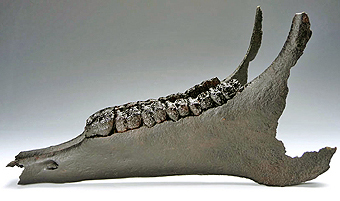
This is a mandible of a pleistocene horse found in Poland—clearly a fine-boned jaw. This proves that even in prehistoric times, not all wild horses were heavy-jawed
This question is especially well answered by a prehistoric horse skull dated approx. 10,000 years B.P. — definitely before domestication took place. It was found in Denmark (the Vedelshave horse) as part of an almost complete skeleton. This prehistoric horse‘s skull is practically identical to a Sorraia skull. It proves two facts: 1) that horses with that kind of skull are well able to survive in the wild (again, today‘s horses prove that anyway, but it appears that prehistoric finds are accepted as more convincing), 2) it proves even that wild horses of Sorraia type existed in prehistoric times.
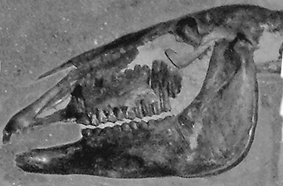
Skull of the Vedelshave horse (left), ca. 10,000 years B.P. (photo courtesy of the Zoological Museum Kopenhaven, Denmark)
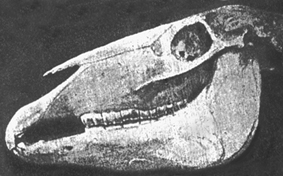
Sorraia skull (photo Ruy d'Andrade). Below, the Sorraia skull's cranium and mandible are superimposed on the Vedelshave horse to demonstrate how identical the two skulls are:
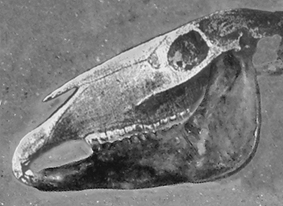
The Sorraia cranium inserted/superimposed on the Vedelshave skull—perfectly congruent!
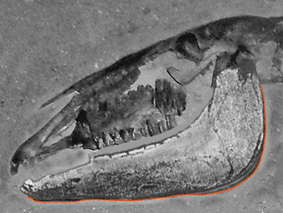
The Sorraia mandible inserted in the Vedelshave skull—a nearly perfect fit. The red line indicates the outline of the Vedelshave jaw
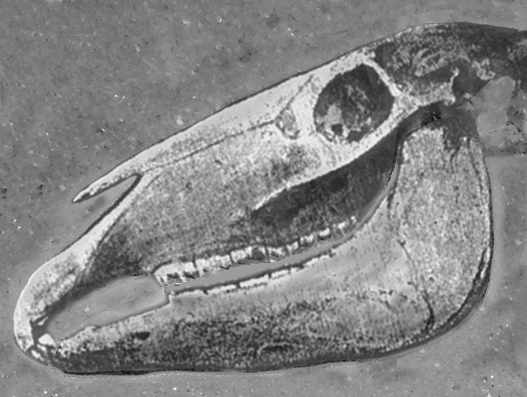
Vedelshave skull with Sorraia cranium and mandible superimposed. It is evident that the Sorraia skull conforms completely to the Vedelshave skull. The slight variation in the bottom outline of the mandible is well within the margin found naturally in individuals of any given population, race, or breed. This should put to rest any discussion over the Sorraia‘s fitness for survival as a wild horse
How well do we know what the Tarpan looked like, as this man also claims that the Tarpan was a wild or feral horse from the steppes of the Ukraine and southern Russia that looked different than today’s Koniks. That it had thick and sturdy bones, was dun or mouse-colored, with a uni-colored (black) mane and tail—nothing like todays Konik. And that archaeozoological research and ancient color genetics would confirm this. He also claims that there was no Polish forest horse, which the Konik were tracing back to. And what about serious mineral shortages in Koniks that lived in forest reserves? That Koniks in forests would need supplementary feed during winters, while Exmoor ponies in Germany and Garranos in northern Portugal allegedly show no signs of malnutrition in forested areas?
Answer: We do not have a good enough description of the Tarpan to be sure about all these details. Whether mane and tail were uni-colored or bi-colored has never been mentioned. The fact that a bi-colored mane was not mentioned does not mean it wasn't present. Again, absence of evidence is not evidence for absence, especially not if all the descriptions we have are so vage. The fact that Koniks, undoubtedly direct descendants of the Tarpan, typically have a bi-colored mane and tail is a pretty good indication that the Tarpan had it also, at least in some of his variants. Otherwise one could argue that one would have to explain how the Konik and the Sorraia got their bi-colored mane and tail. It has to derive from some wild ancestor.
There is discussion of what "wild colors" are and what colors are the result of domestication/selective breeding. So one could argue that the bi-colored mane and tail were a result of domestication/breeding. However, most dun factor horses in domestic breeds have uni-colored manes and tails, the ones with bi-coloration are a minority among them (except Norwegian Fjords). We do not have to theorize about this either, though, because the two-colored mane and tail was already present in prehistoric horses, as can be seen in prehistoric rock art! That art was created long before domestication (examples: caves of Ekain, Cap Blanc, Tito Bustillo). And another aspect: the horses depicted with it can easily be grouped within Tarpan variants.
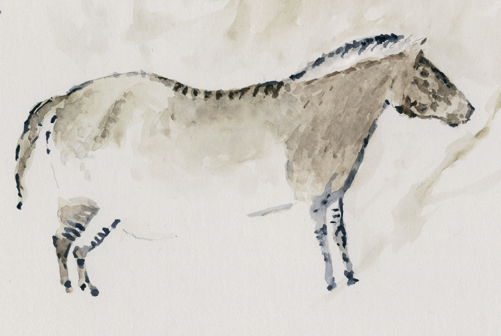
Prehistoric rock art, Tito Bustillo, Spain, showing a bi-colored mane
Finally, nothing has been found in "ancient color genetics" that has any real bearing on these issues. For one thing, the gene for the dun factor has still not been isolated by geneticists, so whatever ancient material is being scrutinized genetically, researchers have no way to know if the horse in question was, for instance, a black or a grulla, a brown or bay or a dun… In other words, they identified bay and black in prehistoric horses, but they have no way of knowing if what they found to be a black was not actually a grulla, or what they found to have been a bay, had not actually been a dun, because they cannot look for the dun gene, which is an additional gene that turns the black into a grulla and the bay into a dun, but which has not yet been found by geneticists.
The Tarpan was described as a light-boned horse, not a thick-boned one. And a drawing made directly from a Tarpan foal clearly portrays a light-boned, not a heavy-boned horse!
The Tarpan was not just found in Russia and today's Ukraine, but in Poland as well and probably even western Europe. The Koniks in Poland that were studied for their nutritional status lived (and still live) in a mainly foresty preserve. The reason they are fed during winter is not that they would not thrive otherwise, but to keep them in the preserve, because the preserve is on a peninsula, and as long as the surrounding water is not frozen, it serves as the boundary. During winter, the lake often freezes over solidly, and the horses might then wander off.
The study can only be viewed as a momentary stock-taking. It does not prove by any means that the horses could not survive there without supplementary feed. The Exmoor ponies in the Solling preserve in Germany also did not well at first, but later adapted to their mostly foresty habitat there. The habitat of the Garranos in Portugal is totally different from any of these two preserves, is not as heavily forrested and the soil—what little there is of it—is also completely different. Comparisons can hardly be made.
That being said, it is nothing new that the concept of the Forest Tarpan is not supported by any of the contemporary Polish scientists and experts. The thinking is that the Tarpans in Poland survived in the forests because that is where they found their last hideouts. On the other hand, it can be observed that primitive horses will readily chose forests to live in if that is where they find feed, or if shade is an issue in hot weather. The horse simply is not the pure steppe animal as which it is often described. In regard to the Polish Konik, there just is not enough evidence to support the theory of a separate "Forest Tarpan" subspecies, or variant, so Vetulani's proposed Equus ferus sylvestris is obsolete.
It is being argued that "mouse-colored" or "rat-colored" would not mean what we normally call "grulla" or "mouse-dun", because many kinds of mice are actually tan or brownish in color. Going by that logic, we would have to call regular duns "mouse-colored"…
Answer: That is an absurd and useless discussion. "Grulla" is Spanish for crane; most cranes are predominantly greyish in color, therefore the term fits. However, if some crane species in some countries have different colors, that doesn't mean "grulla" in those countries would be correct for horses of those colors.
All those terms were originally applied by regular people, not zoologists or geneticists. To most people, and in a sweeping way of description, mice and rats are grey. "Mouse-grey", or "grey as a mouse" are colloquialisms. It was therefore natural to call horses of that color "mouse" or "rat", irrespective of any existing native species that may have been of a different color. The wolf is also called "grey wolf", but if you take a close look you see that his coat shows a variety of buff colors—yet the over-all impression is rather greyish, compared to, say, the rather red coat of a Roe deer in the summer. The term "grulla" is said to have been adopted by the North Americans from South America, however in South America, horses of that color are called "lobo" or "gato".
By the same token, burros or donkeys are also considered "grey", even though black ones, white ones, or brown ones, do exist. It's a question of what is typical, or original. The original wild ass is grey (grulla), that's why "ass-colored", when used in a general statement, means a color similar to grulla.
However, one does not have to theorize about this. There is clear evidence because the very color that in English conversations is called "grulla" or "mouse-dun" is called by the Portuguese "rato", which means "mouse" or "rat"; it is of no consequence in this context if there is a native Iberian mouse of a different color. The usage of the term "rato" (mouse) is indisputable. The same holds true for German: "mausgrau" (grey as a mouse) is firmly embedded in colloquial German, and horses of grulla color are called "mausfalben" (mouse duns). This is something that can't be disputed.
On the other hand, especially darker grullas can give a brownish appearance depending on the surroundings and the light. If in some of the old Tarpan reports they are described as "brown", it may just have been dark grullas, in light of the overwhelming reports that described the Tarpan as grulla, and the grulla color being widespread among Tarpan descendants.
Another aspect that is being held against Koniks is that they still were less shy than other wild living horses, that this would indicate that they were domesticated horses until not too long ago. That horses like Asturcon, Pottoka, Garrano, Exmoor, Karakachan, Serbian mountain pony and some Hucul herds would show more shyness. What is the Konik's status and how does the Konik compare to the Sorraia?
Answer: It is true that Koniks usually are not shy. However, I have a report from a population in a Baltic preserve where they are threatened by bear and wolf, and they definetely adapted a more shy and flighty behavior.
That Koniks did not readapt a wild, shy behavior is mainly due to the way they had to be kept in that first Polish preserve, which is still the largest in Poland. 1) There is a much-frequented road going right through it, so they are exposed to cars and humans all the time. 2) There are some residences on the preserve where they get in contact with humans. 3) They are being fed in the winter for the above-mentioned reasons.
Their tame behavior cannot be held against them, anyway. Przewalski horses in zoos are just as tame. Wild elk and deer and other game are not shy wherever they are protected. You can walk right up to them in National Parks and State Parks in America, or they will go right by you if you are standing in their path. I have walked among free-roaming Garranos as well, and also among the semi-wild ponies on Exmoor, and Przewalskis that were in preparation to being released to the wild. They did not behave much different than Koniks. The Karakachan horse is an old breed and should not even be discussed here, as are the Serbian mountain pony. The Hucul has a long history as a breed, may actually qualify as one of Europe's oldest horse breeds—it is absurd to discuss it as a wild horse candidate. It is a give-away for the bias of this author that the Sorraia is not even mentioned, because in contrast to the Asturcon, Pottoka, Karakachan, Serbian mountain pony and Hucul, the Sorraia had no history as a breed until a few years ago, when the Portuguese started to treat it as such, and still shows shyness wherever it lives under natural conditions. In the Vale de Zebro Refuge they reverted to that behavior fairly quickly, and most will take to flight immediately when seeing someone approach, often at a distance of a hundred yards or more.
At any rate, shyness or the absence of it is not evidence for a primitive status. The feral horses in America, the mustangs, are usually extremely shy, and their domestic ancestry is common knowledge.
As for the Konik's status, there can be no doubt that it is a direct Tarpan descendant. Whether the horses the Konik goes back to were still living wild, like the ones the Sorraia stems from, or more or less domesticated, is unclear. The origin of the ones Vetulani started his project with is pretty well known, but it appears that none of those made it into present-day's population. The Polish experts say on the other hand that the horses from eastern resp. northeastern Poland, which many of today's Koniks trace back to, were even better and more primitive. It is undisputed that at least most of the foundation horses for the Koniks had a couple or more generations in domestication or semi-domestication under their belt before the preservation efforts as a Tarpan descendant started. The more significant difference in comparison with the Sorraia, however, is what took place later, because Koniks have now been bred for generations like any other breed, towards a breed standard (which is not tailored for Tarpan characteristics), for performance qualities, certain looks, etc. As far as that goes, the Konik has several decades on the Sorraia. The Sorraia has been bred like that for just a few years, and only a fraction of them. Most were allowed to just multiply and still lived under natural conditions, and even today this holds true for about half of the population.
The Konik has the advantage of having been used in many renaturation projects, where they live practically wild (albeit usually not under conditions that enhance wild/shy behavior). Probably more Koniks live under such free, natural conditions than in domestication. Only one herd of Sorraias is currently living completely wild



